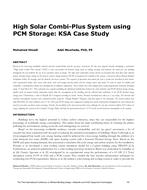Description
Based on the increasing worldwide tendency towards sustainability and the “go green” movement, the idea was targeted towards developing a standalone “High Solar Combi Plus System” (HSC+) that can provide all thermal energy loads of cooling, heating, and domestic hot water for any building throughout the year without the use of an auxiliary source of energy. The high solar combi-plus system consists of evacuated tube heat pipe solar collector panels, thermal energy storage in the form of a phase change material (PCM) to maintain the stability of the system, a hot water driven lithium bromide absorption chiller, the heating, and the domestic hot water systems. The sequence of operation and control for such a system was described in four modes: solar regeneration mode, solar source only mode, solar and storage mixing mode, and the storage source only mode. In order to study its validity and reliability, a mathematical model was developed for its different components. These models were then coupled with a fully programmed calculator developed using “Visual Basic “. This calculator was capable of finding the optimized combination between the solar collectors and PCM thermal energy storage, together with all annual hourly simulation results from the consumption of the building and the collected solar radiation, to the PCM thermal energy storage level. Furthermore, a villa in Riyadh KSA designed according to Saudi Arabia Thermal Standard was taken as a case study. The thermal and electrical consumption baselines were simulated hourly using the “Design Builder” Program, and then input in the calculator. The results showed that only 80m2(861 ft2) solar collectors and 3.5 m3 (925 gal) PCM storage were enough for running this system continuously throughout the year without the need for any other auxiliary source of energy. Finally, the feasibility of the novel system shows that although the very low electrical tariff in KSA deters its usage, adopting this system in the Country’s Energy Policy will help the government decrease 12.7% of the overall electrical consumption in the country.
Citation: 3rd Intl Conf: Efficient Bldg Design
Product Details
- Published:
- 2018
- Number of Pages:
- 9
- Units of Measure:
- Dual
- File Size:
- 1 file , 2.9 MB
- Product Code(s):
- D-ICEB18-C023




